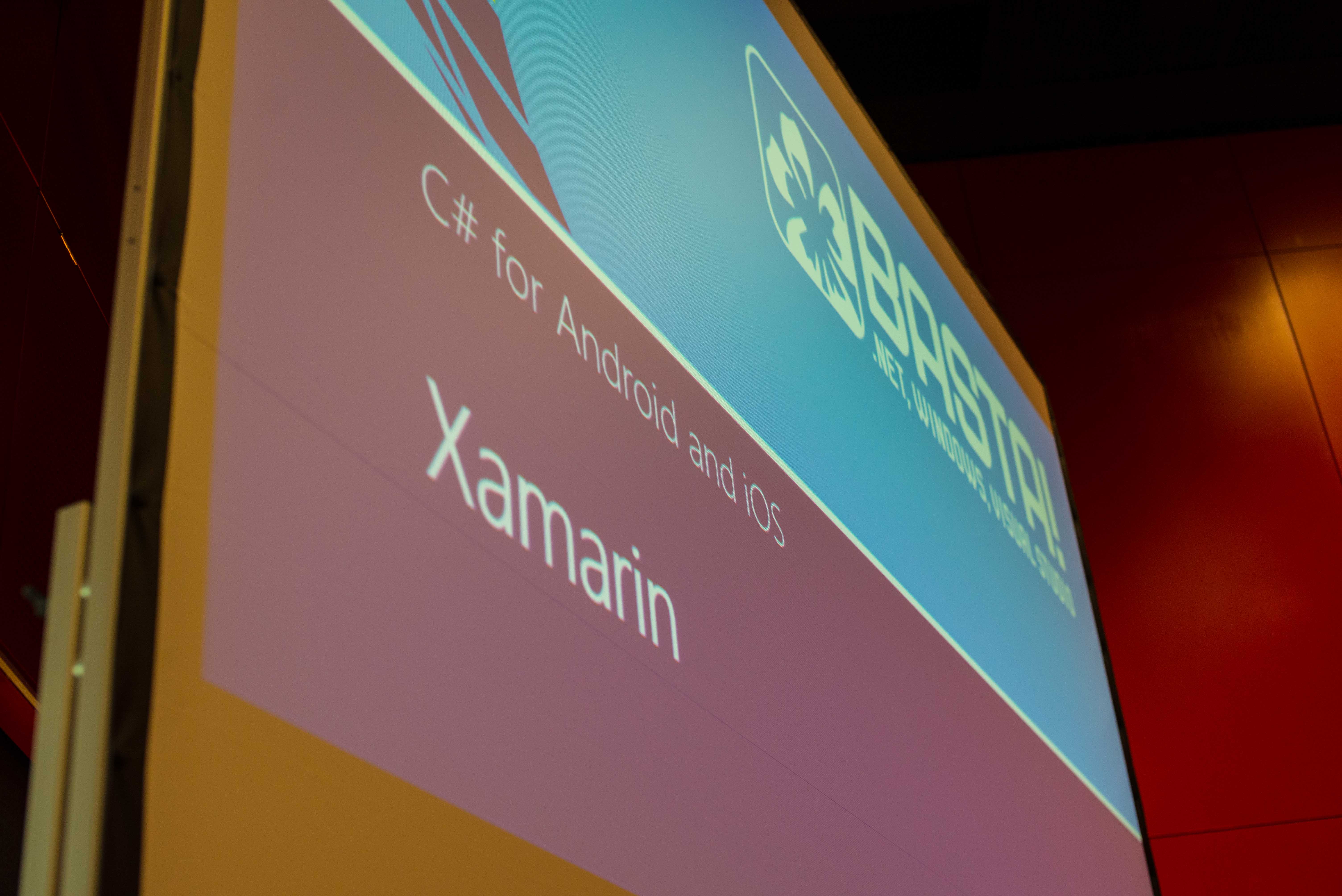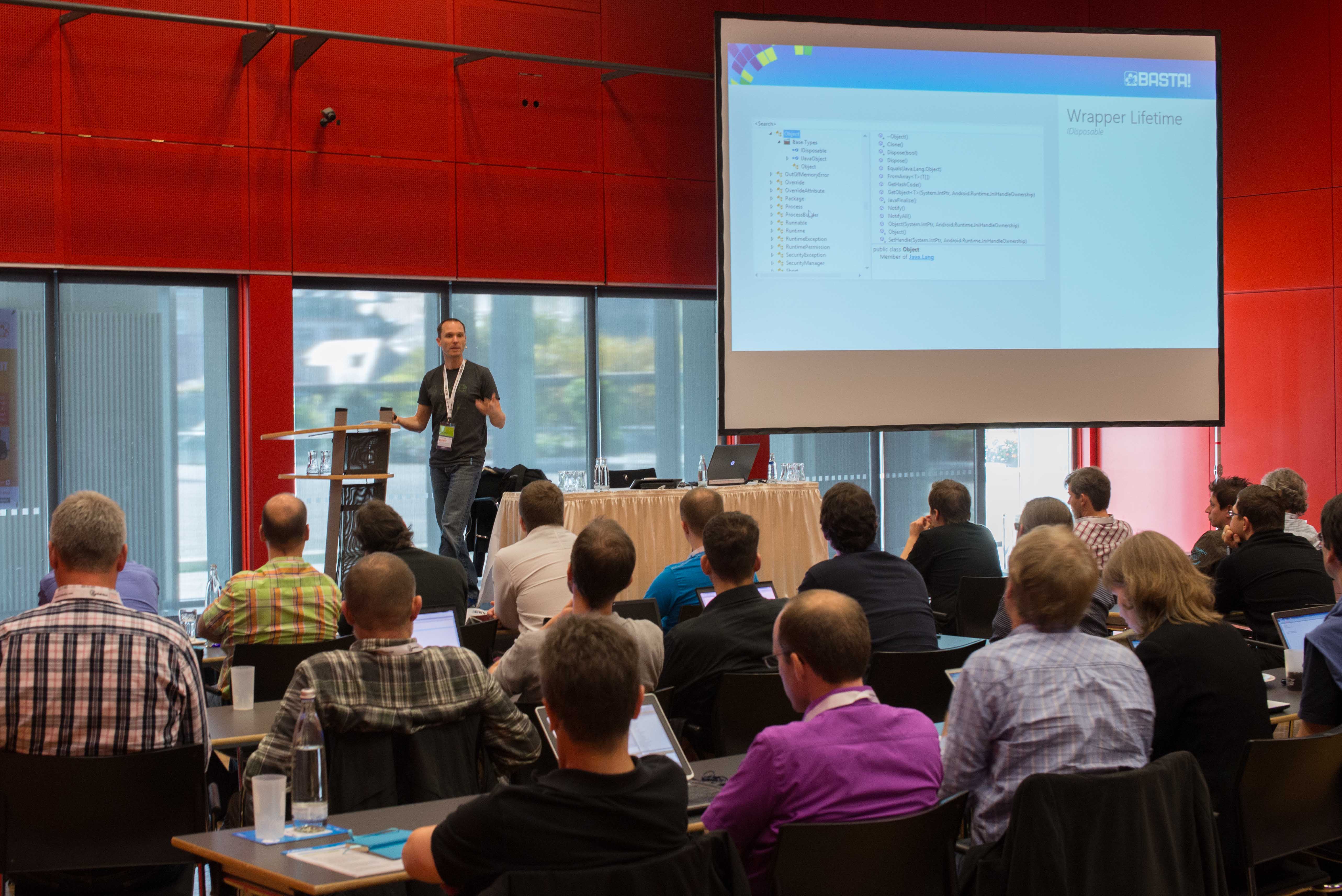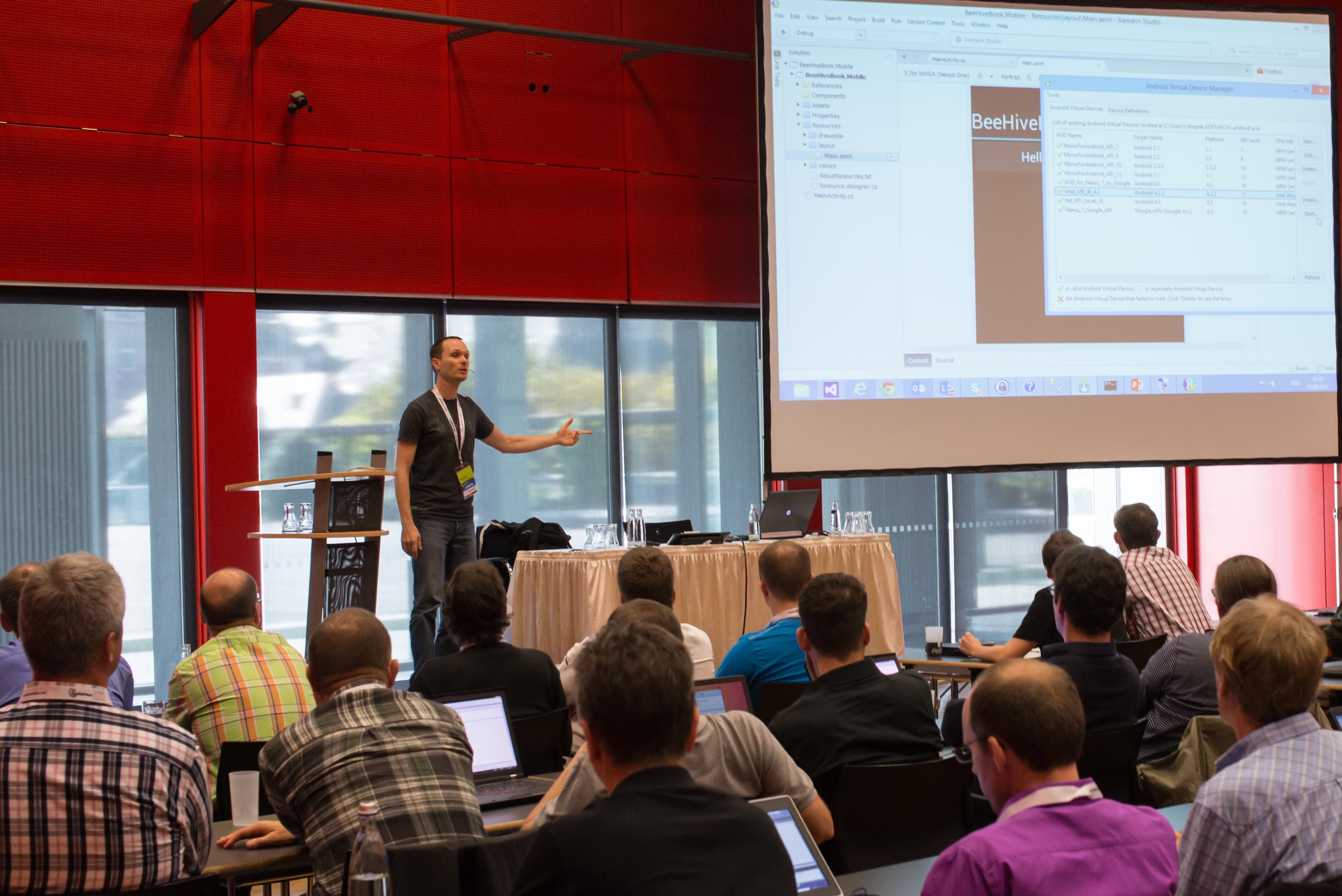BASTA 2013 - Android Development with Xamarin, C#, and Azure Mobile Services
24 September 2013 - .NET, Android, Azure, Visual Studio
The Xamarin and Mono tools enable C# developers to use their existing knowledge and experience to write apps for Android and iOS. At the BASTA 2013 conference I did a session about that topic. During the session I showed a sample that used SQLite on the phone and Windows Azure Mobile Services as its backend in the cloud. In this blog article I publish my slides as well as the sample code.
Photos of the Session
Slides
If you prefer PDF, you can download the slide deck here.
Sourcecode
The slidedeck contains a step-by-step description of how to build the sample. However, it does not include the complete sourcecode as I did not write it manually during the session. People who are interested in playing with the sample can download the source code files here. If you don't want to download the entire sample you can also take a look at the most important pieces of code below. BTW - the sample is about managing honey bee hives. The reason why I have chosen this example is because honey bees are my hobby. If you want to know more you can check out my private blog (German).
Platform-Independent Data Access Layer
In my example I wanted to demonstrate the cross-platform usage of ADO.NET (with its Task-based async API) for building a simple data access layer. I wanted my bee hive management app to be offline-enabled. Therefore it uses this layer to access a SQLite database on the phone. However, it could be used e.g. on the server as a data access layer for an web app or web API, too.
using System;
using System.Collections.Generic;
using System.ComponentModel.Composition.Hosting;
using System.Data;
using System.Data.Common;
using System.Reflection;
using System.Threading;
using System.Threading.Tasks;
namespace BeeBook.Mobile
{
public abstract class BeeBookDatabase : IDisposable
{
private bool disposed = false;
~BeeBookDatabase()
{
this.Dispose(false);
GC.SuppressFinalize(this);
}
protected DbConnection Connection { get; set; }
private static BeeBookDatabase current;
public static BeeBookDatabase Current
{
get
{
if (current == null)
{
// Lazy create and open global database
BeeBookDatabase.current = GlobalContainer.Container.GetExportedValue<BeeBookDatabase>();
BeeBookDatabase.current.CreateOrOpenDatabaseAsync();
}
return BeeBookDatabase.current;
}
}
public abstract string DatabaseFileLocation { get; }
public abstract Task CreateOrOpenDatabaseAsync();
protected abstract string GenerateSqlHiveTableCreate();
protected abstract IReadOnlyList<string> GenerateSqlDemoDataInserts();
protected virtual string GenerateSqlNumberOfHives()
{
return "SELECT COUNT(*) FROM Hive;";
}
protected virtual string GenerateSqlGetAllHives()
{
return "SELECT * FROM Hive;";
}
protected virtual string GenerateSqlGetHiveById(int hiveId)
{
return string.Format("SELECT * FROM Hive WHERE Id = {0};", hiveId);
}
public async Task CreateOrUpdateSchema()
{
using (var command = this.Connection.CreateCommand())
{
command.CommandText = this.GenerateSqlHiveTableCreate();
command.CommandType = CommandType.Text;
await command.ExecuteNonQueryAsync();
}
}
public async Task GenerateDemodata()
{
using (var command = this.Connection.CreateCommand())
{
command.CommandType = CommandType.Text;
command.CommandText = this.GenerateSqlNumberOfHives();
var numberOfHives = (long)await command.ExecuteScalarAsync();
if (numberOfHives == 0)
{
foreach (var stmt in this.GenerateSqlDemoDataInserts())
{
command.CommandText = stmt;
await command.ExecuteNonQueryAsync();
}
}
}
}
public async Task<IReadOnlyList<Hive>> GetAllHives()
{
var result = new List<Hive>();
using (var command = this.Connection.CreateCommand())
{
command.CommandType = CommandType.Text;
command.CommandText = this.GenerateSqlGetAllHives();
using (var reader = await command.ExecuteReaderAsync())
{
var idOrdinal = reader.GetOrdinal("Id");
var hiveNameOrdinal = reader.GetOrdinal("hiveName");
var latOrdinal = reader.GetOrdinal("lat");
var longOrdinal = reader.GetOrdinal("long");
while (await reader.ReadAsync())
{
result.Add(new Hive()
{
Id = (int)reader.GetInt64(idOrdinal),
HiveName = reader.GetString(hiveNameOrdinal),
Lat = reader.GetDouble(latOrdinal),
Long = reader.GetDouble(longOrdinal)
});
}
}
}
return result;
}
public async Task<Hive> GetHiveById(int hiveId)
{
Hive result = null;
using (var command = this.Connection.CreateCommand())
{
command.CommandType = CommandType.Text;
command.CommandText = this.GenerateSqlGetHiveById(hiveId);
using (var reader = await command.ExecuteReaderAsync())
{
if (await reader.ReadAsync())
{
var idOrdinal = reader.GetOrdinal("Id");
var hiveNameOrdinal = reader.GetOrdinal("hiveName");
var latOrdinal = reader.GetOrdinal("lat");
var longOrdinal = reader.GetOrdinal("long");
result = new Hive()
{
Id = reader.GetInt32(idOrdinal),
HiveName = reader.GetString(hiveNameOrdinal),
Lat = reader.GetDouble(latOrdinal),
Long = reader.GetDouble(longOrdinal)
};
}
}
}
return result;
}
public void CloseDatabase()
{
this.CheckDisposed();
if (this.Connection != null)
{
this.Connection.Close();
this.Connection.Dispose();
this.Connection = null;
}
}
public void Dispose()
{
this.Dispose(true);
}
public void Dispose(bool disposing)
{
if (disposing)
{
this.CloseDatabase();
}
this.disposed = true;
}
protected void CheckDisposed()
{
if (this.disposed)
{
throw new ObjectDisposedException(this.ToString());
}
}
}
}And this is the sample implementation (derived from the class above) for SQLite on the Android phone.
using System;
using System.IO;
using System.Threading;
using System.Threading.Tasks;
using Mono.Data.Sqlite;
using System.ComponentModel.Composition;
using System.Collections.Generic;
namespace BeeBook.Mobile
{
[Export(typeof(BeeBookDatabase))]
[PartCreationPolicy(CreationPolicy.Shared)]
public class BeeBookDatabaseMobile : BeeBookDatabase
{
public override string DatabaseFileLocation
{
get
{
this.CheckDisposed();
return Path.Combine(
System.Environment.GetFolderPath(System.Environment.SpecialFolder.Personal),
"hives.db3");
}
}
public override async Task CreateOrOpenDatabaseAsync()
{
this.CheckDisposed();
// If database is already open, close it
if (this.Connection != null)
{
this.CloseDatabase();
}
// Create database file if it does not exist
var dbFileName = this.DatabaseFileLocation;
if (!File.Exists(dbFileName))
{
SqliteConnection.CreateFile(dbFileName);
}
// Create connection and open it async
this.Connection = new SqliteConnection(string.Format("Data Source={0}", this.DatabaseFileLocation));
await this.Connection.OpenAsync();
}
protected override string GenerateSqlHiveTableCreate()
{
return "CREATE TABLE IF NOT EXISTS Hive ( Id INTEGER CONSTRAINT PK_Hive PRIMARY KEY ASC AUTOINCREMENT, hiveName TEXT, lat REAL, long REAL );";
}
protected override IReadOnlyList<string> GenerateSqlDemoDataInserts()
{
return new[] {
"INSERT INTO Hive ( hiveName, lat, long ) values ( 'Nähe Rapsfeld', 48.279381, 14.239203 )",
"INSERT INTO Hive ( hiveName, lat, long ) values ( 'Kürnbergerwald', 48.285819, 14.2355 )"
};
}
protected override string GenerateSqlNumberOfHives()
{
return "SELECT COUNT(*) FROM Hive;";
}
protected override string GenerateSqlGetAllHives()
{
return "SELECT * FROM Hive;";
}
protected override string GenerateSqlGetHiveById(int hiveId)
{
return string.Format("SELECT * FROM Hive WHERE Id = {0};", hiveId);
}
}
}Adapter (Data Source for ListView)
The Data Access Layer is used by an adapter which acts as the data source for the main activity:
using Android.Content;
using Android.Views;
using Android.Widget;
using BeeHive.Mobile;
using System.Collections.Generic;
namespace BeeBook.Mobile
{
public class HiveAdapter : BaseAdapter<Hive>
{
private IReadOnlyList<Hive> items = new List<Hive>();
private readonly LayoutInflater inflater;
public HiveAdapter(Context context)
{
this.inflater = (LayoutInflater)context.GetSystemService(Context.LayoutInflaterService);
this.RefreshAsync();
}
public override bool HasStableIds { get { return true; } }
public override int Count { get { return this.items.Count; } }
public override Hive this[int position] { get { return this.items[position]; } }
public override long GetItemId(int position) { return this.items[position].Id; }
public override View GetView(int position, View convertView, ViewGroup parent)
{
var item = this.items[position];
var view = this.inflater.Inflate(Resource.Layout.HiveItem, null);
var itemTextView = view.FindViewById<TextView>(Resource.Id.ItemText);
itemTextView.Text = item.HiveName;
itemTextView.Click += (o, e) =>
{
var hiveDetailsActivity = new Intent(this.inflater.Context, typeof(HiveDetails));
hiveDetailsActivity.PutExtra("Id", item.Id);
this.inflater.Context.StartActivity(hiveDetailsActivity);
};
return view;
}
public async void RefreshAsync()
{
this.items = await BeeBookDatabase.Current.GetAllHives();
this.NotifyDataSetChanged();
}
}
}Main Activity
The main activity simply displays a list of bee hives. The data is read from the adapter shown above. Note that the main activity uses an action bar menu item to display a Sync option. If the user clicks on this menu item, the data from the phone's SQLite database is transferred into the cloud using Windows Azure Mobile Services.
using Android.App;
using Android.OS;
using Android.Views;
using BeeBook.Mobile;
using Microsoft.WindowsAzure.MobileServices;
using System.Linq;
using System.Threading.Tasks;
namespace BeeHive.Mobile
{
[Activity(Label = "BeeHive.Mobile", MainLauncher = true)]
public class MainActivity : ListActivity
{
private static readonly MobileServiceClient MobileService =
new MobileServiceClient("https://myaccount.azure-mobile.net/", "mykey");
protected override async void OnCreate(Bundle bundle)
{
base.OnCreate(bundle);
// Activate the action bar
this.RequestWindowFeature(WindowFeatures.ActionBar);
var db = BeeBookDatabase.Current;
await db.CreateOrUpdateSchema();
await db.GenerateDemodata();
this.ListAdapter = new HiveAdapter(this);
}
public override bool OnCreateOptionsMenu(Android.Views.IMenu menu)
{
var inflater = this.MenuInflater;
inflater.Inflate(Resource.Menu.MainMenu, menu);
return true;
}
public override bool OnOptionsItemSelected(IMenuItem item)
{
if (item.ItemId == Resource.Id.menu_sync)
{
Task.Run(async () =>
{
var hivesInLocalDb = await BeeBookDatabase.Current.GetAllHives();
var table = MainActivity.MobileService.GetTable<Hive>();
var hivesInRemoteDb = await table.ToListAsync();
foreach (var missingHive in hivesInLocalDb.Where(h => hivesInRemoteDb.Count(hRemote => hRemote.HiveName == h.HiveName) == 0).ToArray())
{
missingHive.Id = 0;
await table.InsertAsync(missingHive);
}
});
return true;
}
else
{
return base.OnOptionsItemSelected(item);
}
}
}
}Hive Details With Google Maps Activation
using Android.App;
using Android.OS;
using Android.Views;
using BeeBook.Mobile;
using Microsoft.WindowsAzure.MobileServices;
using System.Linq;
using System.Threading.Tasks;
namespace BeeHive.Mobile
{
[Activity(Label = "BeeHive.Mobile", MainLauncher = true)]
public class MainActivity : ListActivity
{
private static readonly MobileServiceClient MobileService =
new MobileServiceClient("https://youraccount.azure-mobile.net/", "yourkey");
protected override async void OnCreate(Bundle bundle)
{
base.OnCreate(bundle);
// Activate the action bar
this.RequestWindowFeature(WindowFeatures.ActionBar);
var db = BeeBookDatabase.Current;
await db.CreateOrUpdateSchema();
await db.GenerateDemodata();
this.ListAdapter = new HiveAdapter(this);
}
public override bool OnCreateOptionsMenu(Android.Views.IMenu menu)
{
var inflater = this.MenuInflater;
inflater.Inflate(Resource.Menu.MainMenu, menu);
return true;
}
public override bool OnOptionsItemSelected(IMenuItem item)
{
if (item.ItemId == Resource.Id.menu_sync)
{
Task.Run(async () =>
{
var hivesInLocalDb = await BeeBookDatabase.Current.GetAllHives();
var table = MainActivity.MobileService.GetTable<Hive>();
var hivesInRemoteDb = await table.ToListAsync();
foreach (var missingHive in hivesInLocalDb.Where(h => hivesInRemoteDb.Count(hRemote => hRemote.HiveName == h.HiveName) == 0).ToArray())
{
missingHive.Id = 0;
await table.InsertAsync(missingHive);
}
});
return true;
}
else
{
return base.OnOptionsItemSelected(item);
}
}
}
}If a user clicks on a bee hive row in the main activity's ListView, the hive's details are displayed. The detail form contains a butten which should show the location of the bee hive in Google maps. Here is the code for the hive detail activity:
using Android.App;
using Android.Content;
using Android.OS;
using Android.Widget;
using BeeHive.Mobile;
namespace BeeBook.Mobile
{
[Activity(Label = "Hive Details")]
public class HiveDetails : Activity
{
protected override async void OnCreate(Bundle bundle)
{
base.OnCreate(bundle);
this.SetContentView(Resource.Layout.HiveDetails);
var hiveId = this.Intent.GetIntExtra("Id", -1);
if (hiveId != (-1))
{
var hive = await BeeBookDatabase.Current.GetHiveById(hiveId);
if (hive != null)
{
this.FindViewById<EditText>(Resource.Id.HiveNameText).Text = hive.HiveName;
this.FindViewById<EditText>(Resource.Id.LongitudeText).Text = hive.Long.ToString();
this.FindViewById<EditText>(Resource.Id.LatitudeText).Text = hive.Lat.ToString();
this.FindViewById<Button>(Resource.Id.DisplayLocation).Click += (s, e) =>
{
var uriString = string.Format("https://maps.google.com/maps?q=loc:{0}+{1}", hive.Lat, hive.Long);
var uri = Android.Net.Uri.Parse(uriString);
var intent = new Intent(Intent.ActionView, uri);
this.StartActivity(intent);
};
}
}
}
}
}








